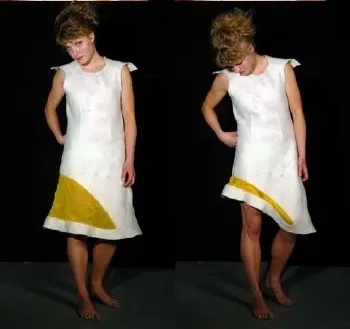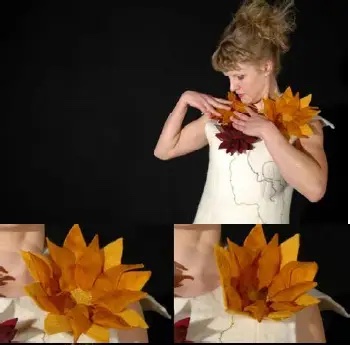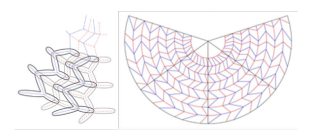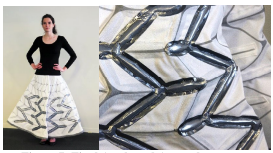Precedent Research 2
By: Natalia Santiago
Kukkukia and Vilkas: Kinetic Electronic Garments and Expressive Fashion
In this paper Joanna Berzowska and Marcelo Coelho from XSLab in Concordia University explore the creation of kinetic garments using an alloy called Nitinol. In the article Nitinol is explained to be a combination of nickel and titanium that when treated to acquire a specific shape is able to retain it. Therefore, this material can take on any shape but when heated will return to its “original” or given shape. In this experiment Berzowsk and Coelho intigrate Nitinol into textiles in order to produce movments. Their main goal was to use body hear or ambien temperatures to create reactive and expressive garments. Using this technique they created two garments:
1. Vilkas Dress

Uses hand stiched Nitinol in the yellow cotton fabric to slowly pull up the hem line of the dress.
2. Kukkia Dress

The dress contains three animated flowers. The nitinol is stiched onto the back of the flowers. When heated it causes each of them to open and close.
- What feature of the work could we specifically evolve into a technique for wearable kinetic sculpture or costume?
- The idea of the kinetic hemlines is a very interesting idea that can lead to the creation of adaptable and reactive garments (according to your enviroment).
- What details of the artwork or concept are not immediately apparent and how do they inform the work?
- One thing that is not initially apparent is the machinery behind the motion of the fabric. Ones initial thoughts are motors or electronic devices however the use of Nitinol allows for a natural motion powered by heat rather than electricity.
- Are there closely related works?
- At the time that the paper was written they mentioned that the only other documented work that intigrated Nitinol wires into textiles was the Oricalco shirt from Grado Zero Espace However after looking it up there has been a lot of research done on Nitinol and its ability to animate textiles with heat.
- Links to Research done on Nitinol and Textiles:
- Functional Textiles Driven by Transforming NiTi Wires: https://researchfeatures.com/transforming-niti-wires/
- Oricalo Shirt from Grado Zero Espace: https://www.gzinnovation.eu/material/7/shape-memory-materials
- A NiTi Alloy Weft Knitted Fabric for Smart Firefighting: https://iopscience.iop.org/article/10.1088/1361-665X/ab18b9/pdf#:~:text=nitinol%20incorporated%20into%20woven%20or,heat%20or%20heat%20during%20ironing.
Awakened Apparel: Embedded Soft Actuators for Expressive Fashion and Functional Garments
In this paper Laura Perovich, Philippa Mothersill, and Jenniger Broutin from the MIT Media Lab explain how they created garment that is able to move and change in an origami-like-fashion using pneumatic actuators. For the dress they chose a drawstring-like pattern so that the dress could shorten or lengthen depending on whether the actuators were inflated or deflated.

Inflation folding pattern. The blue lines show the actuatoron s located on top of the fabric and the red are those located on the underside. 
Final skirt prototype with actuators.
- What feature of the work could we specifically evolve into a technique for wearable kinetic sculpture or costume?
- Similarly to the first paper this research article also explores the idea of modular garments that could be changed according to a persons mood, occasion or enviromental factors. Therefore I believe that having a kinetic sculpture or costume that is reactive to the enviroment around it would be very interesting.
- What details of the artwork or concept are not immediately apparent and how do they inform the work?
- One thing that is not initially apparent is the specifics of the pneumatics. Althgouh some of the pouches are visible in the front of the dress a lot of the mechanism is hidding inside. However once the dress inflates it is apparent that the lines created by the actuators inside the skirt are not only decorative but functional.
- Are there closely related works?
- Yes, it was hard to find more in the area of garments but throughout the past few classes we have already seen a lot of examples of pneumatic actuators being used for many artistic and functional experiments.
Leave a Reply
You must be logged in to post a comment.